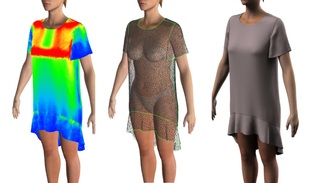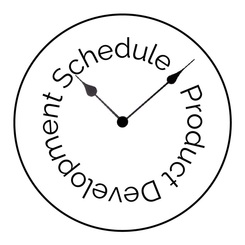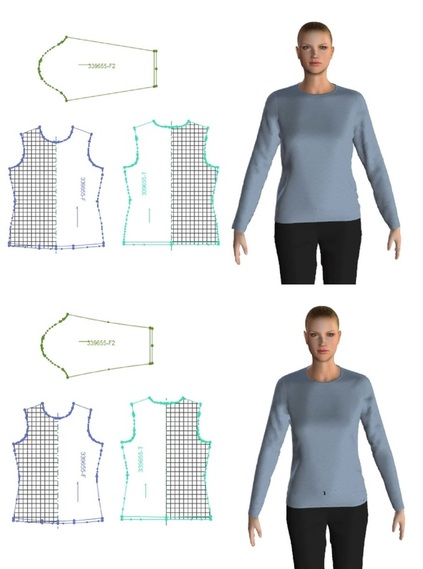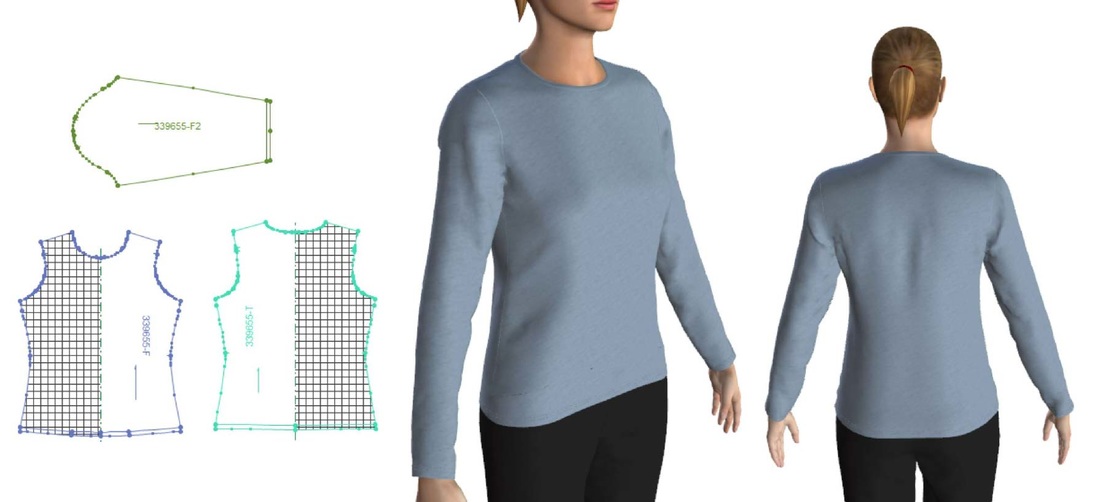|
The process for creating a well fitting garment can be difficult to explain. There is a lot more to the process than assigning a set of measurements. A nice fitting garment needs to make the wearer look great, not simply fit around the body and stay put. Even those in the industry struggle to understand the nuances. Common questions: ⦁ Why doesn't it fit, we sent the factory measurements? ⦁ Why do samples from two factories fit different? ⦁ Why do some customers love our fit and others are completely disappointed? If these problems were easy to solve, technical designers would be out of work. Assigning garment measurements is not enough to create a well fitting garment. A square table and a round table can measure the same dimension across, but they don't fit in the same space or convey the same aesthetic. What makes a garment fit well? ⦁ Balance. Horizontal seams should be parallel to the floor. Vertical seams should be perpendicular to the floor. ⦁ No drag lines. Those puckery areas that point to a problem. ⦁ Comfort. Garments should allow movement for the end use they are designed. ⦁ Fit preference. Not everyone wants their clothes to fit the same. Yes, designers ask to break the above rules sometimes to push the boundaries of style. Pattern shapes are as important as measurements. Two garment patterns can have the same measurements and fit differently. The pattern shape can be the difference between a garment that appears dated or one that feels contemporary and stylish. The tee shirts in the below images share the same measurements that would be included in a basic measurement specification. The first has hip shape in the side seam. The sleeve is straight, allowing ease at the elbow. The second has less room at the hip. You can see the pant is bleeding through in the 3D render. The sweep and hip could both be eased out to maintain the same shape and aesthetic. The elbow has also been shaped to give a slimmer effect. Both of these garments would be acceptable fits. But you probably wouldn't find a single brand running both. For consistency one pattern shape should be followed consistently. The below garment follows the same measurement specification. But it does not fit well. The shoulder slope is too flat (angle of the shoulder seam). This is causing the garment to hike (CF is pulling up). The armhole shape forms a V where the side seams meet. The sleeve cap shape is also different. This is causing excess fabric along the armhole. These are the types of issues technical designers and pattern-makers spend time correcting in live fit sessions and communicating to factories. Communicating the pattern shapes to the factory along with measurements creates a better fitting initial prototype. Vital time and effort are saved for both the factory and the retailer.
Ways to communicate pattern shapes to manufacturers: ⦁ Send a block pattern. Allow the factory to adjust to match the new design. ⦁ Send the pattern from a previous style that sold well. ⦁ Create a pattern for the new style to send to the factory. Why is creating the pattern for the new style listed last? Most large retail brands do not dedicate in house resources to this effort. Pattern makers located at the factory can often create the pattern cheaper. They also can work directly with engineers to make sure the pattern is efficient to sew, fits the marker well, and is adjusted for fabric shrinkage. Designers who want a high degree of control over garment fit and drape may employ an in-house pattern-maker. The second step is to make sure the factory followed direction. Manufacturers should always send a copy of the pattern with the fit sample for evaluation. Electronic pattern-making can save valuable time. Even if you are not creating patterns in-house, a system can be used for receiving and reviewing patterns created by manufacturers. The pattern you sent to the factory to follow can be overlayed with the newly created pattern for comparison. Consistency Consistency is key. Your customers need to feel like your tee shirts feel similar to your sweaters. If your marketing materials show a sweater layered over a button-down shirt, can the customer achieve that look purchasing the same size of sweater and shirt? Consistency requires communication and management. The leaders of technical design and design are charged with the responsibility to maintain fit consistency and provide direction. Verbal or written communication is not enough. Technical designers and designers need to visualize the intended fit. Invite designers and technical designers to join fittings for other product categories. You can also hold a show and tell with staff from multiple product categories to discuss the fit. Document the fittings with photos or video that can be shared. The right fit So all your garments fit consistently. But is it the right fit? If you are a mass market retailer how do you decide how your garment should fit in the first place? Pop quiz: 1. Ask a designer to dictate the ease over body and pick a fit model they think looks good in their designs. 2. Compare your fit to your competitors. 3. Analyze the body shapes of your target market. The answer is really a bit of all three. Design should help guide the brand aesthetic, so they should be involved but the fit process is not a dictatorship. You need know what competitors are doing, but be aware that competitors product may not fit better. Body scan data can give you insight to the body shape of your target market. Organizations such as TC2 or Alvanon can advise how to interpret the data. ASTM provides standardized body measurements for infants and children. The goal should be to please majority of your customers, not everyone.
0 Comments
 This weeks blog post is for technical designers and pattern-makers. You are challenged to create perfectly fitting garments in minimal time. The garments need to fit various body shapes, not just the fit model. Taking time to strategize how to create a smoother fit process amidst the challenges seems like a luxury. The following are some tips and reminders compiled for you. Spend more time training There are many viewpoints on how a garment should fit. Pattern-makers are trained differently around the world. They also grow up in different cultures. Sharing photos of your fit models allows pattern-makers to become familiar with the body shape. Holding fittings via Skype or recording fit sessions can help factory pattern-makers interpret the vision of designers and technical designers. Some companies assemble a manual for suppliers. The manual contains photos of garments that fit well and represent the fit preferences of their customers. The right tools Make sure your factories are using the same tools as you. Do the factory pattern-makers all have the same dress forms as your technical designers or pattern-makers? Do your factories have access to your product lifecycle management (PLM) system? Is their internet reliable to access your PLM system? Sharing the same tools allows everyone to meet the same goals. Optimize technology There is a lot of free, dependable technology. Sometimes, we simply forget to capitalize on what is available. You can text message your overseas vendors for free with Whatsapp. Skype works great for collaboration. You can hold live fittings, share your screen and talk through photos or fit issues, or review samples with the vendor on a dress form before they are shipped to you. Advanced imaging methods, such as 3D pattern-making and virtual samples allow you to visualize your pattern in the correct fabric before proceeding with physical samples. 3D virtual prototypes can offers numerous ways to improve fit. See the previous Fireflyline post Virtual Samples vs Fit Samples. Tracking the status of styles in the development process also requires technology. The status of a sample can easily be lost in the shuffle. Virginia Meckley recommends keeping documents to track the status of styles within the fit process. “I use tracking docs that tell me where everything is at a glance. [I] color code categories for quick visual assessment of work flow and keep [the] team engaged with on going training. This gives me the flexibility to expedite and not lose time trying to find something.” Tracking documents can be created in a spreadsheet. Many PLM systems also track development status. Vendors can be given direct access to save time communicating via e-mail or retrieving large files from another location. Rushing is not always best Spending more time evaluating an initial prototype or spending the time to create a good pattern block can prevent countless iterations of samples. Waiting on correct sample yardage for the initial fit prototype can save time. Xochil Scheer reminds us “Never use muslin except as a draping tool. Even your first sample should be made in a fabric that is very similar to or exact to your final garment. If you're making a blouse in silk chiffon, muslin will never look, feel or hang the same on the body as silk chiffon.” A few days of patience waiting on information or materials may ultimately save time. Sometimes, a deep breath and a moment to think is all that is needed to create better product. If you have additional tips, please share in the comments section. Collaboration can make all our lives a little easier.  The first step to reduce your development time is to build a strong knowledge of your schedule. Once you have built your schedule, you can begin to analyze and evaluate. There are great reasons to reduce your development time:
Evaluation Understand the reason each development task takes the time it does. Track the actual duration of each task versus the expected duration from the schedule. Most software scheduling tools will allow you to record the actual task durations and allow you to see if the schedule is staying on time. If tasks are consistently early or late, by how many days are they early or late? Talk to those responsible for the activities. Why were they early or late? You can learn a lot by sitting down with the people responsible for completing the tasks. Eliminate tasks Pull-off the bandages. You know they exist. Tasks that originated as a short term fix to a problem. Does that problem still exist? If it does, can you solve the root cause? It may take more time initially to solve the problem, but will smooth out the development process in the long run. Are any tasks redundant? Are there departments doing the same task? Are there any tasks that both you and a supplier are doing? For example, is the supplier sending information which you are entering into a PLM or ERP system? Can the supplier enter the data directly? Focus on the critical path Once you have eliminated unnecessary or redundant tasks, identifying improvements gets harder. The tasks on the critical path add up to your total schedule. Eliminating or reducing the time each task takes is necessary to reduce your total timeline. You will need to address real issues that are slowing you down. These issues could be related to processes, staff, corporate structure, or environmental. Eliminate Capacity Bottlenecks Guess what? Some bottlenecks are people, but not in the way you think. Sometimes the problem isn’t the people who can’t get things done, but the people you can’t get things done without. If one person has to sign off on every idea that goes into development, that person is a bottleneck. There is a limited amount of work that person can review in a day. What happens if that person is out of the office unexpectedly due to an illness? Make people more flexible and interchangeable. Everyone wants to be indispensable, but if that means work stops because one person is not present that is not good for the well-being of the company. Most leaders are familiar with the book Good to Great by Jim Collins. You may recall that part of what defines great companies are humble leaders who set their companies up for success beyond their tenure. If you are a leader, trust your staff to make good decisions. If you have to review everything, you are a bottleneck. Also, place value on the individuals who offer creative solutions, not those that crank out the most work or look the busiest. You may find some tasks are late because one department or group is behind. Is it a long-term problem or due to a recent change. Analyze if a particular department needs additional resources or training. Has turnover been high and there are more new staff than usual? Is one group full of recent hires and would benefit from additional training? The role of technology Technology can eliminate tasks or reduce the duration of tasks. However, you will not understand the impact of technology without going through the above evaluation steps. Technology can solve issues with communication or reduce the burden on people. Understand the issue it is you are trying to solve before trying to solve it with software. Implementation of new technology is usually accompanied by process changes. There are always improvements to be made. Hopefully, you have thought of a few you can implement as you read through the article. If you have had a great idea, share it in the comments! |

